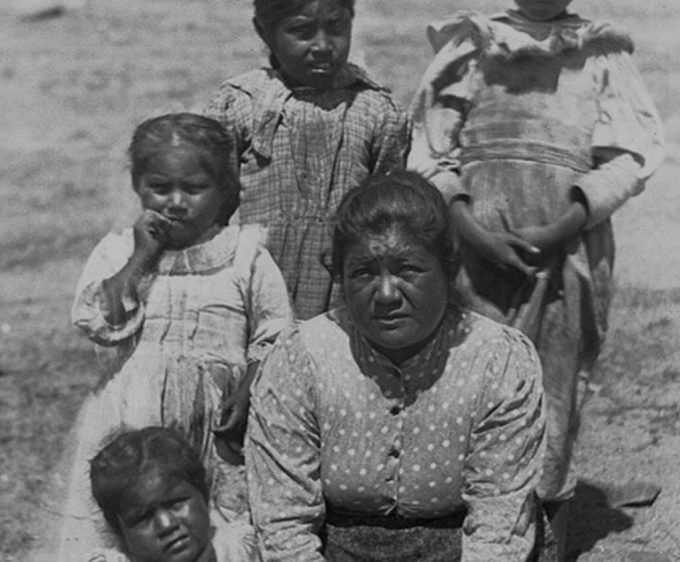1850s
California child slavery
When we think about slavery we tend to think of the Deep South – of African laborers toiling under the sweltering sun in the cotton fields of Georgia, the tobacco plantations of the Carolinas, or the lush gardens of Mississippi. But California? It’s not even on the radar for most people, including those who are reasonably well-versed in American History. Yet at California’s First State Constitutional Convention, the government enacted an Indian slavery law under which Indigenous people of all ages could be forced into indentured servitude for a decade or more. A pair of Indians sold at auction could fetch the seller a year’s wages, and it was perfectly legal to murder Indian parents to capture their children for sale into slavery. Known as the Act for the Government and Protection of Indians, it led to the enslavement of more than 25,000 Natives in California, including thousands of children.
California was admitted to the United States in 1850, becoming America’s 31st state. During the first decade of its existence, the State of California carried on a series of privatized wars of extermination against its Indigenous population. The state’s first governor, Peter Burnett, openly called for the extermination of Indian people. The former slave owner from Tennessee expressed his vision for a whites-only West. “That a war of extermination will continue to be waged between the races until the Indian race becomes extinct must be expected,” Burnett said. “While we cannot anticipate this result but with painful regret, the inevitable destiny of the race is beyond the power or wisdom of man to avert.”

California governor Peter Burnett. (Alamy Images)
Murder, kidnapping, and rape of Indigenous people was common. It is estimated that nearly 10,000 California Natives were murdered during this dark period in the state’s history, and more than 370 massacres of Indian people have been documented. Mass settlement had created insatiable demand for farmworkers and domestic servants, and the Act paved the way for indentured servitude of Native people to meet that need. Non-Indians were empowered to arrest Indian adults for loitering and other offenses. The captives were then sold to the highest bidder who could “apprentice” the Indian for a term of 10 years or more. Californians were so accustomed to treating Indians as powerless property that there was little known opposition to the laws. It was simply business as usual.
Roaming bands of “baby hunters”
The impact on Indian children was incomprehensible.
The Act for the Government and Protection of Indians allowed non-Indians to obtain Indian children by going before a justice of the peace and securing a certificate which allowed them to have the care, custody, control and earnings of these children. Female children who became “apprentices” before the age of 14 were forced into servitude until they were 21; for males it was 25. If they were taken between the ages of 14 and 20 the term was even longer. White people didn’t have to pay the children anything, and they were not free to leave. Slavery.

Photo: James George Wharton, 1903 (via Wikimedia Commons)
Younger children were trained as domestic servants while the older ones were usually laborers. Many were abused in unspeakable ways, and young girls who fell into the hands of single men were particularly vulnerable. Neglect was rampant, and it was not unusual for half-naked children to be found in the streets having been beaten, abused and left for dead. Criminal charges against settlers were extremely rare.
The hunting and capture of children became a twisted form of commercial enterprise. The law had the impact of making Indian children into valuable possessions, which encouraged kidnapping on a mass scale. Newspapers of the day published stories about so-called “baby hunters” who attacked and murdered Indian parents to acquire their children for sale or as personal possessions. Rewards were offered for the capture of children who escaped.

The Act certainly had the desired effect. Between approximately 1850 and 1870 the Indigenous population of California decreased from an estimated 150,000 to 30,000. By 1900 there were just 16,000 Natives remaining in California. Although the Act was officially repealed in 1863, four months after President Abraham Lincoln’s Emancipation Proclamation, it wasn’t entirely nullified until the 1930s.
In June of 2019 California Governor Gavin Newsom issued a formal apology via executive order on behalf of the State to its Native population, saying California needed to reckon with its dark history. “It’s called genocide,” he said. “That’s what it was, a genocide. No other way to describe it. And that’s the way it needs to be described in the history books.”
Newsome announced the formation of a “truth and healing council,” to examine the relationship between tribes and the State. “California Native American peoples suffered violence, discrimination and exploitation sanctioned by state government throughout its history,” Newsom said. “We can never undo the wrongs inflicted on the peoples who have lived on this land that we now call California since time immemorial, but we can work together to build bridges, tell the truth about our past and begin to heal deep wounds.”
“The hunting and capture of children became a commercial enterprise“



